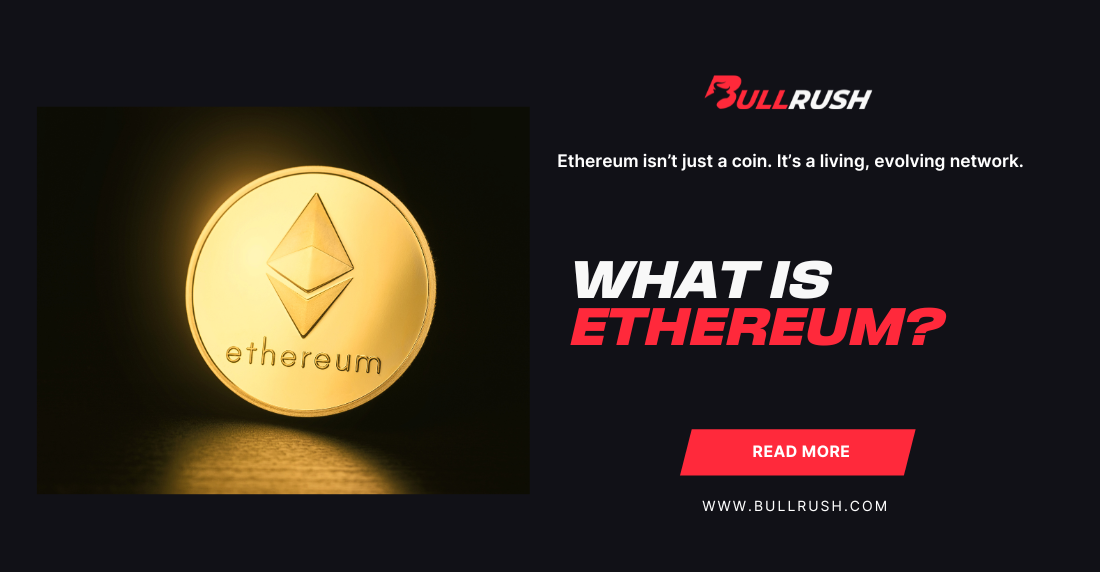
What Is Ethereum?
Ethereum doesn’t just move money. It moves ideas, applications, and entire industries, without a middleman.
To most traders, Ethereum comes to mind as the second-biggest cryptocurrency after Bitcoin. But calling it “just another coin” is like calling an iPhone “just a phone.” Ethereum is the infrastructure: a decentralized operating system that powers thousands of apps, financial tools, NFTs, and more.
Imagine if every banking app, game, or social network ran on code you could see, verify, and never needed to trust blindly. That’s Ethereum. And the fuel behind it all? ETH. Every smart contract, NFT mint, token swap, or DeFi loan burns a little ETH to keep the machine running.
Ethereum isn’t trying to replace Bitcoin; it’s building an entirely new digital economy on top of it. In this article, we’ll break it down in plain words and show you why ETH belongs in every trader’s playbook, especially if you’re gunning for the BullRush leaderboard.
Ethereum in Plain English
Picture this: a computer that spans the globe, doesn’t belong to anyone, and can run code that no one can alter or censor. That’s Ethereum.
Ethereum uses smart contracts, self-executing programs that automate agreements, procedures, or digital actions, instead of storing and transferring coins like Bitcoin. NFT drops, lending platforms, and fully decentralized exchanges (DEXs) without a company backing them are all powered by these contracts.
And the best part? Anyone can build on Ethereum. It’s like an open-source app store where code replaces customer service and protocols replace policies. The network is secured by thousands of nodes, and every action requires a bit of ETH (gas) to execute.
Tip: Think of Ethereum as the foundation of a digital city. ETH is the energy. The more people build, the more ETH is needed to power the ecosystem.
Quick recap:
- Ethereum runs code, not just currency
- Smart contracts enable DApps (decentralized apps)
- ETH is used to power every transaction
- Open-source and decentralized by design
Why Ethereum Matters: Automating Trust with Smart Contracts
What makes Ethereum truly powerful isn’t just that it works; it’s about the trust, or the lack of need for it. Smart contracts don’t need lawyers or middlemen. They run exactly as coded. Want to swap tokens instantly with no one in between? Done. Want to stake, borrow, lend, or insure, all without a bank? Easy.
This has given rise to entire sectors:
- DeFi, where users become their own bank
- NFTs, where art and ownership collide
- DAOs, where organizations run without CEOs
But Ethereum isn’t perfect. Network congestion can send gas fees soaring. Speed can be a bottleneck. That’s why upgrades like The Merge and the upcoming sharding rollout matter. They’re aimed at making Ethereum faster, cheaper, and more scalable.
Tip: Keep a watchful eye for upgrade events; they’re often followed by price spikes or dips. These technical changes have the potential to open up great trading opportunities.
Quick recap:
- Smart contracts = trustless automation
- Ethereum is the base layer of DeFi, NFTs, and Web3
- ETH is burned as fees; this can make it deflationary
- Scalability upgrades are in progress (sharding, L2s)
ETH as a Trading Asset: Utility + Volatility = Opportunity
ETH isn’t just fuel for developers; it’s fire for traders. With deep liquidity and big daily price moves, ETH is one of the most actively traded assets in the world. It reacts sharply to news, adoption trends, protocol upgrades, and even gas fee fluctuations.
Here’s the edge: ETH is tied to on-chain activity. When people use Ethereum more, minting NFTs, trading DeFi tokens, and interacting with apps, it burns more ETH, making supply shrink. That dynamic introduces a long-term bullish force into what’s already a volatile asset.
And unlike meme coins, ETH has a fundamental network demand. That means price isn’t just hype; it’s tied to real usage.
Tip: Don’t just chart ETH. Watch the network. Sites for monitoring ETH can show gas activity, NFT volume, and DeFi TVL, all of which drive ETH’s price action.
Quick recap:
- ETH is volatile, liquid, and event-driven
- Price is influenced by network usage and upgrades
- Supply is deflationary post-Merge = bullish over time
- Ideal for both swing and intraday strategies
Ethereum in BullRush: Where the Fastest Minds Compete
In BullRush, ETH is one of the top picks for a good reason. It reacts quickly to narratives, responds to technical setups, and trends hard when the market’s moving.
We’ve seen traders dominate competitions by riding ETH on:
- News-based breakouts (ETF speculation, upgrade launches)
- Technical reversals at key levels (using 9 EMA and 21 EMA crossovers)
- Pair trades vs. Bitcoin, Solana, or L2 tokens (ETH/BTC ratio)
It’s not just about speed. It’s about adapting. In short-form challenges, traders lean on fast EMAs and scalp setups. In longer events, like Profit Sprint, they track DeFi growth or whale wallet activity to predict momentum days in advance.
Tip: Paper trade ETH with a risk model. Track how ETH responds to macro news (like CPI reports) versus on-chain trends. Then bring that playbook into your next BullRush comp.
Quick recap:
- ETH offers both speed and structure
- Great for short and long-format competitions
- Responds to both technical and fundamental catalysts
- Top traders build ETH-specific strategies to climb the ranks
Ethereum: Built to Be Traded
As mentioned, Ethereum isn’t a coin you just buy and hold. It’s a living, evolving network powering the most explosive sectors of crypto. From NFTs and DeFi to smart contract automation, Ethereum is where Web3 is being built in real time.
For traders, that means endless opportunity. ETH delivers volatility, volume, and narrative-driven movement every single week. Whether you’re chasing breakouts or swing trading trend shifts, Ethereum gives you the tools, and the price action, to execute.
This isn’t just about trading crypto. It’s about understanding the technology behind the future of finance and using it to win.
👉 Want to test your ETH strategy in a live and safe environment? Join a BullRush trading competition today. It’s your chance to refine your edge, climb the leaderboard, and prove your playbook in real time.
FAQs: Ethereum for Traders
Q: Is Ethereum a cryptocurrency or a platform?
Both. Ethereum is a blockchain platform that runs decentralized apps. ETH is its native cryptocurrency used for fees and rewards
Q: How are smart contracts different from apps?
Smart contracts are self-executing code. They don’t rely on third parties and can power apps, swaps, loans, and more… trustlessly.
Q: Why are Ethereum gas fees sometimes so high?
When the network is busy, it is only logical that demand for block space rises, pushing up fees. Layer 2 solutions help reduce this.
Q: Can ETH be deflationary?
Yes. After the Merge and EIP-1559, more ETH can be burned in fees than issued, reducing the overall supply.
Q: Is Ethereum good for short-term trading?
Absolutely. ETH has high liquidity and strong reactions to news, upgrades, and on-chain activity; perfect for technical traders.



